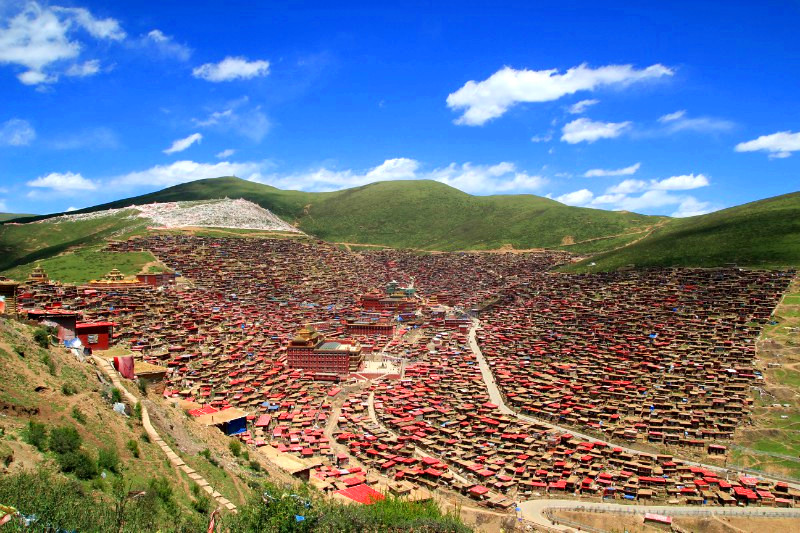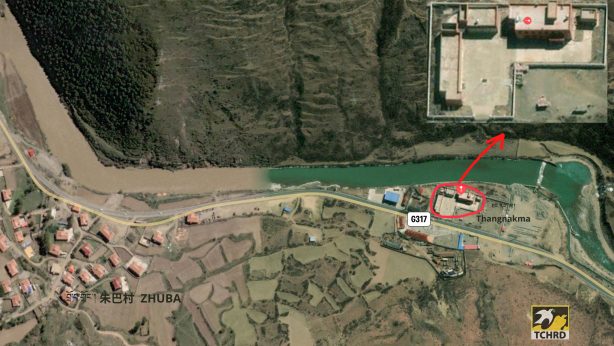Demolition of leading Tibetan Buddhist institute reveals no change in China’s policy of religious repression

The ongoing demolition of monastic dwellings and eviction of monks and nuns at Larung Gar Buddhist Institute, one of the leading centres for Buddhist scholarship and practice in Tibet, demonstrate that religious freedom remains a distant reality for religious believers in Tibet.
Since 20 July, Chinese government-employed demolition squads have torn down more than half of the targeted 1000 monastic residences at Larung Gar Buddhist Institute in Serthar (Ch: Seda) County in Kardze (Ch: Ganzi) Tibetan Autonomous Prefecture, Sichuan Province. The target will be achieved by the end of this year. The demolition order issued early this year also requires the eviction of thousands of monks and nuns from the institute. The ceiling requirement of 5000 monastics – 2000 monks and 3000 nuns – has necessitated the eviction of the rest of the residents. The total number of monastics, apart from lay and foreign practitioners, at the institute hovered around 10,000 before the demolition began.
At stake is the freedom of religion and belief of thousands of Buddhist practitioners including Tibetan, Mongolian and Chinese. Since its establishment in 1987, the institute has attracted a steady stream of disciples from Mainland China as well as Thailand, Taiwan, Hong Kong, Singapore, Malaysia, and Korea. Buddhist practitioners from all of the PRC’s provinces, five autonomous regions, and four municipalities have studied at the institute at different times. The Tibetan students hailed from various counties in Tibet Autonomous Region (TAR) and Tibetan autonomous areas including Lhasa (Ch: Lasa), Ngari (Ch: Ali), Nagchu (Ch: Naqu), and Chamdo (Ch: Changdu) in TAR; Serthar, Drango (Ch: Luhuo), Tawu (Ch: Daofu), Dartsedo (Ch: Kangding), Kardze, Derge (Ch: Dege), and Nyagrong (Ch: Xinlong) in Sichuan Province; and Tibetan autonomous prefectures of Golok (Ch: Guoluo), Jyekundu (Ch: Yushu) and Malho (Ch: Gannan) in Qinghai Province.
Sources told TCHRD that students from Mainland China and foreign countries are also being evicted in large numbers. The exception is the lay and tantric practitioners who have not been affected. Among them, only elderly practitioners are allowed to remain. A considerable number of monastic and lay practitioners had already been evicted before 20 July this year. In late 2013, TCHRD received confirmed information that nuns from TAR who had studied at the institute were temporarily detained and threatened with criminal detention if they returned to continue their studies. In 2014, county authorities in Chamdo and Diru (Ch; Biru) ordered to recall home their family members who were studying at Larung Gar or Yachen Gar. Monks and nuns were threatened with removal of their names from county family registration lists if they did not return.
Larung Gar is one of the few and earliest religious institutes in Tibet where nuns are provided equal opportunities to study as monks. The institute houses the first nunnery in Tibet that offered curricula leading to women getting the degree of khenmo, the feminine equivalent of the khenpo degree, similar to a doctorate degree, that is usually given after 13 years of rigorous study in five areas of Buddhist scriptures, particularly in the Nyingma and Kagyu traditions of Tibetan Buddhism. In 1990, the institute awarded the first khenmo degrees and since then, no less than a hundred nuns have successfully acquired the degree. For many other nuns who are either disabled, widowed or divorced, the institute has provided a lifeline in terms of spiritual and secular sustenance.
The current dismantling of the institute bears striking resemblance to an earlier demolition carried out in 2001. A study of the 2001 and the current demolition shows that nothing much has changed in the past 15 years in terms of China’s religious policy (Click here to download TCHRD’s full report on Larung Gar’s demolition in 2001). If anything, the second demolition of Larung Gar serves as evidence that change in Chinese leadership or China’s growing international profile has done little to guarantee religious freedom in Tibet. Chinese authorities continue to remain suspicious and paranoid of religious personalities and religious activities, even those with no political background. Religion is tightly controlled through an elaborate policy of repressive laws, regulations, and government indoctrination campaigns.
The 2016 demolition order issued by the Sichuan provincial authorities cited decisions taken at the Sixth Tibet Work Forum Conference and the Second National Work Conference on Religion. Larung Gar residents were told that the order for demolition and eviction came from higher authorities with president Xi “taking a personal interest in the matter.” At the conference on religion held in Beijing from April 22 to 23, president Xi Jinping stressed that “religious groups must adhere to the leadership of the CPC and support the socialist system and socialism with Chinese characteristics.”
In 2001 when students appealed against the expulsions, they were told that orders had come directly from Beijing from president Jiang Zemin. Similar to 2016, there was no written evidence to that effect but local authorities maintained that they were merely implementing the order from higher authorities. At the 1993 National United Front Work Conference and at the 2001 National Religious Affairs Conference, president Jiang issued three authoritative directives that summed up the government’s approach towards religion: 1) Implement the party’s religious policies; 2) Strengthen control over religious affairs in accordance with the law; and 3) Guide religion to be compatible with socialism. President Jiang also presided over the Third Tibet Work Forum in 1994 where measures to tighten control over monasteries and nunneries by identifying religious institutions as “breeding grounds and hotbeds” for “splittist activities” were introduced. It resulted in “patriotic education” and “strike hard” campaigns that were conducted across Tibet to force monks and nuns to denounce the Dalai Lama and pledge allegiance to the Chinese Communist Party.
Written orders issued by the Sichuan provincial authorities in 2001 and in 2016 specified that only 1400 and 5000 residents respectively would be allowed to remain at the institute. In both cases, government indoctrination or ‘patriotic education’ campaigns were held rigorously before the arrival of the demolition crews and government officials who identified residents to be evicted. Similarly, government officials from various counties and prefectures were called in to cajole residents to voluntarily return to their respective hometowns. In 2016, government officials were found luring some residents with cash for voluntary departure. In 2001, nuns were “offered various worldly incentives – money, six yaks and six dri (female yak), construction and repair of house, jobs and matrimonial alliances.”
In March 1999, the Sichuan provincial authorities issued a circular that criticised the size of the institute, disorganised management, inferior health and sanitary conditions, and accused the institute of having many negative aspects. This circular laid the foundation for the eventual demolition and downsizing of the institute in 2001. In late July 2016, the Kardze prefectural authorities stated similar reasons, with additional details on providing fire safety measures at the institute. To support their ‘fire safety’ claims, the authorities referred to the destruction wrought on the institute by a massive fire in January 2014. The cause of the fire that destroyed about 100 houses and injured some nuns at the institute remains unknown. The same month another major fire broke out at Lithang Monastery in Lithang County in Kardze TAP and the cause was not known.
A recent petition written by a Tibetan inside Tibet has made its way to social media. A copy of the petition is available here. To make the petition politically palatable, it begins with a routine congratulatory greetings to the leaders of the Chinese government and Chinese Communist Party for working towards ‘human rights, religious freedom, equality and democracy’. The author then casts doubts on the Chinese government’s publicly professed reasons for downsizing the institute and expresses concern over the damaging consequences it could have on the preservation and promotion of Tibetan language, culture and religion. The author published a somewhat similar petition in June, a copy of which is still available here. The translation of the second petition dated 1 October is as follows:
Petition on the Welfare of Serthar Larung Gar
1 October 2016
First of all, greetings to all the great Party leaders!
Today I would like to submit this petition for the second time regarding the welfare of the great religious institute of Serthar Larung Gar.
- In recent years, under the leadership of comrade Xi Jinping and the Party, there has been a definite positive result in the areas of human rights, religious belief, equality, democratic progress and cultural education in our country. For this, I would like express my immense happiness and appreciation. Moreover, I express my gratitude to the Party for convening the Sixth Tibet Work Forum in 2016 [sic] purposely for the welfare of the Tibetan minority nationality, which is a matter of joy. I offer my praise and appreciation for the love of the Party and deeds of the leaders including Xi Jinping.
- However at the Sixth Tibet Work Forum a resolution was passed to decrease the population at Serthar Larung Gar. It is difficult for me to understand the actual aim of the Party for passing the resolution. I am, therefore, waiting for an accurate clarification from the Party. If it is really about limiting the monastic population, then the smallest of all the universities in PRC such as the North West Nationalities University last year enrolled over 30,000 students. The total population of Larung Gar is less than 20,000. So there is no reason to reduce the population. If the reason were because monasteries are different from schools, then I would say they are same. Buddhist studies including logic are taught at monastic institutions. Secular knowledge such as politics, military, economics, and dialectics, etc., is imparted in schools. It is the content of the learning that differs, but both are places where knowledge is imparted. If political reasons are involved, then Larung Gar is not a political centre. The monks and nuns in Larung Gar are studying the Three Baskets [the three classifications of Buddha’s teachings]. They are mere practitioners of the Three-fold Trainings [Discipline, Concentration and Wisdom]. No one in the institute has engaged in political activities in the past and no one will in the future.
- For the Chinese nation, this Institute represents the beauty and greatness of democracy and freedom. For Tibet, it is the centre of Tibetan culture. For the general Buddhists, it is an important field of spiritual faith. Therefore, it is the responsibility of a legitimate nation to protect and support it.
- If the purpose of a constitution is to respect and protect truth and justice and to exterminate evil and deceit, then it is the collective responsibility of both the people and the government not to act against the letter and spirit of the constitution. For this reason, I believe it is important to consider the constitutional provisions including the freedom of religious belief, freedom of education, and freedom of protecting benefits.
- For a democratic nation like PRC, it is important to consult with the wishes of all Buddhist believers including Tibetan Buddhists on reforming Larung Gar rather than making decisions based on the whims of a handful of government leaders.
- If the reform work is carried out without respecting the wishes of the people, then who will take responsibility for the negative consequences on unity between nationalities, love and trust between the people and the government and the nation’s image?
- Larung Gar is one of the most important cultural centres of the Tibetan people. The downsizing of the centre might cause enormous destruction to Tibetan language, culture and religion. We request the Party to consider the future of our minority language and culture.
- Larung Gar has become the soul force for Buddhist believers. Reducing its size will prove a huge loss to Buddhism. I urge the Party to consider the future of Buddhism and individual welfare.
- Larung Gar is an important source of peace and harmony for the Tibetan people. It is obvious that due to the [teachings] of the abbots and lamas of this institute, incidents of theft, loot and robbery and violence such as murder, fight and conflict have gone down in the past many years in all three provinces of Tibet. For the sake of social stability and mutual harmony, we call on the government to stop this plan.
- It is the obligation and constitutional duty of a legitimate government like the PRC that implements and protects democracy to protect the interests and beliefs of the people. Therefore, this plan actually violates important aspects of the law and democratic principles.
- I request the Party and the government authorities to seriously consider my petition and not construe it as politically motivated.


